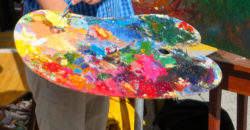A is for Ankle
 I was on the ground without warning, my palms bearing the brunt of the sudden fall. It surprised me, this new ground-level viewpoint; I was down in the dark, my bag having splayed its belongings around me on the rough sidewalk concrete. “Where is my Burt’s Bees pomegranate lip balm?” I remember thinking. And then David was kneeling beside me: “Are you okay?” he asked.
I was on the ground without warning, my palms bearing the brunt of the sudden fall. It surprised me, this new ground-level viewpoint; I was down in the dark, my bag having splayed its belongings around me on the rough sidewalk concrete. “Where is my Burt’s Bees pomegranate lip balm?” I remember thinking. And then David was kneeling beside me: “Are you okay?” he asked.
1) Don’t over prepare – we didn’t have the opportunity to do our usual pre-session night-before final planning, so were by necessity completely tuned into what was unfolding in the room rather than what we wanted to unfold.
2) Be completely present – there is nothing like extreme pain to ground you in the present. Having not prepared the evening before, we were acutely attuned to every nuance in the room. There was nothing but “now” in that room that morning.
3) Some things just don’t need doing – moving is overrated. When on crutches and in pain, every movement hurts. It’s amazing how much we move that we don’t need to move. Sit still, stop moving your head, ground yourself.
4) Give up owning the room to the people in it – it’s easy, as a teacher or trainer, to want to perform or be liked or be smart or funny or impressive…but learning isn’t about you—it’s about them. Open up the space for them, and get out of the way.
5) Admit your vulnerability – I had to own my pain before that group, to be fully human with them, to invite them into the solution.
6) Don’t buy into other people’s descriptions of your condition – it was only after I got home that my doctor here (and, more importantly, my brilliant physical therapist—if you’re in the Asheville area and ever need one, he’s the one for you, just call and I’ll give you his name) determined the full extent of my injuries—not a “sprain” as the Albuquerque hospital indicated, but “complete disruption” of all ligaments around my right ankle, as well as a fractured talar joint. Had I known at the time, I wonder if I would have been able to give that workshop? Would I have bought into the severity of my condition and given up? Maybe.







